
“THE race to find bigger and better ways to destroy each other is a terrifying prospect, one which has never left the public consciousness for 70 years,” says artist John Marc Allen.
Currently running at Blackpool’s Hive, How I Learned to Stop Worrying is Allen’s enlightening and provocative exhibition on the human capacity for planetary destruction and the mass psychology underpinning it.
Nuclear conflict invaded Allen’s thinking at the age of 10, in the form of Frankie Goes to Hollywood’s Two Tribes. The nine-minute Annihilation Mix (1984) included lines from the government’s Protect and Survive campaign, such as: “If your grandmother or any other member of the family should die whilst in the shelter, put them outside, but remember to tag them first for identification purposes.















